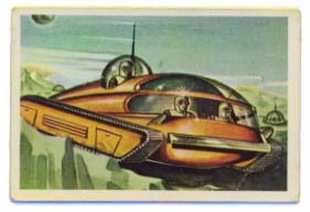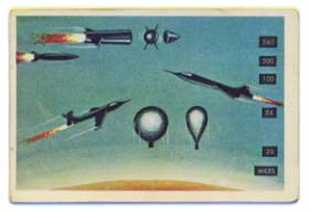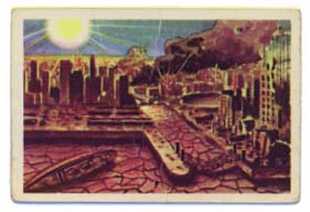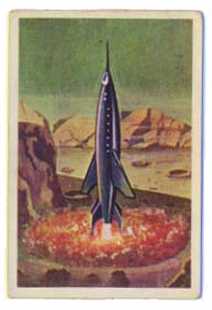Rocket Cards! (11-25)
Spaceships, Space Exploration, and Rockets, circa 1957
Added: 1999-02-06
This the second of three pages showing my set of rocket cards. The other two pages are:
- Rocket Cards! (includes Background)
- Rocket Cards! (26-50)
This page contains cards 11 through 25 of the set.
- 11. GIANT TO OTHER WORLDS
- 12. TANKETTE LABORATORY ON MOON
- 13. RETURN FROM THE MOON
- 14. COSMIC TELEVISION
- 15. COMPARATIVE FLIGHTS IN SPACE
- 16. SUN POWERED MOON ROCKET
- 17. WITH SPEED OF LIGHT TO SATURN
- 18. ARTIFICIAL GRAVITY ON SATELLITE
- 19. SPACEMAN STRUCK BY METEOR
- 20. U.S. DAISY CARTRIDGE
- 21. PERPETUAL LIGHT ON LAND, SEA, AIR
- 22. DEVASTATING SUNSHINE
- 23. LANDING ON VENUS
- 24. MINERAL EXCAVATIONS ON PLANETS
- 25. MANNED SATELLITE IN ACTION
 11. GIANT TO OTHER WORLDS
11. GIANT TO OTHER WORLDS
Here we have a close-up of that giant to other worlds, the fantastic bird of the future, the spaceship. Its ceramic nose cone is tipped with a radar device. It is equipped with rockets and fuel tanks and a whole system of guidance instruments within. The pilots and navigators inside the ship will have to take constant measurements and adjust the course of the craft by switching a low-powered motor on and off. The slightest error in speed or direction may cause the pilot to miss his objective, run out of fuel and be lost.
 12. TANKETTE LABORATORY ON MOON
12. TANKETTE LABORATORY ON MOON
Following preliminary observations, men will land on the moon. They will study its hills and valleys, climate and gravitation, using a special tankette laboratory. This can easily cover the icy ground with its caterpillar tread. It will be provided with scientific instruments. Because of the lack of oxygen, moon visitors will wear special helmets and live in hermetically-sealed huts. In order to reach the moon, however, it will be necessary to first solve the problem of "escape velocity" -- a speed for rockets or spaceships of 25,000 m.p.h.
 13. RETURN FROM THE MOON
13. RETURN FROM THE MOON
How will spacemen return to the earth? The bulky spaceship, once in our atmosphere, will become white hot and explode. Thus the crew must shift to a streamlined spaceglider and abandon the spaceship. As the glider hits the highest levels of the atmosphere, it will still be travelling at a great speed. It will emerge into space again, retarded by air resistance. After a series of such manoeuvres, the glider will shed most of its excess speed and avoid the danger of being burned up. Its landing will take a few hours.
 14. COSMIC TELEVISION
14. COSMIC TELEVISION
Before manned space travel begins to the moon, there will be unmanned expeditions in spaceships, possibly with robots landing, taking "observations" and returning to earth. There will also be trips with manned spaceships, equipped with cosmic TV to record vital information about the moon before a landing is attempted. Differing from ordinary TV, cosmic television will be transmitted more slowly to huge receiver aerials, recorded on tapes, cleared from interference, then viewed and studied. This will yield secrets about our nearest neighbor, 238,840 miles away.
 15. COMPARATIVE FLIGHTS IN SPACE
15. COMPARATIVE FLIGHTS IN SPACE
Our card shows the different heights obtained by various types of manned and unmanned space travellers, and some plans for the future. Starting from the bottom, we find the highest manned balloon, which reached a height of 19 miles, and was flown by U.S. Major Simmons. Then there is X-2, the U.S. rocket plane in which Captain Apt made a 24 mile high jet flight in 1956. The more powerful X-15 is expected to reach a height of 100 miles, flying at 3,500 m.p.h. The U.S. project, Farside, will attempt to shoot a rocket from a 20 mile high balloon launching site to a height of 4,000 miles at 17,000 m.p.h.
 16. SUN POWERED MOON ROCKET
16. SUN POWERED MOON ROCKET
One of the great problems in interplanetary travel is how to get heavy fuel and equipment aboard a spacecraft and into space. Scientists are studying the use of the sun's rays for a super-fuel to create "atomized" substance. An ordinary rocket will be used to launch the spaceship; then, the heavy starting rocket falls to earth by parachute. The lighter spaceship, equipped with large sun-mirrors, starts sucking in great quantities of powerful "atomized" oxygen. The free fuel will provide speeds up to 25,000 m.p.h.
 17. WITH SPEED OF LIGHT TO SATURN
17. WITH SPEED OF LIGHT TO SATURN
Our cards shows a spaceship streaking towards the weird ringed planet of Saturn, 750,000,000 miles from earth. The ring is actually a flat layer of gas. Our spaceship is travelling at the fantastic speed of light -- 186,000 miles per second. This dream of science, to create a photon-propelled spaceship, using the extremely tiny particles of light rays, is a long way off. At the speed of light men will be able to cover distances in a short space of time that would ordinarily take several lifetimes.
 18. ARTIFICIAL GRAVITY ON SATELLITE
18. ARTIFICIAL GRAVITY ON SATELLITE
Manned artificial earth satellites (or space stations) will be of varied designs. One type is shown in our drawing. The outside ring will contain air-conditioned compartments with high-powered instruments. Scientists will work here, and observe the vast cosmos through the airtight glass windows. The inside portion, beginning with the section marked in red, will be spinning about continuously in order to create artificial gravity. This will make for pleasant conditions for the scientists, who will not have to wear heavy helmets and space suits.
 19. SPACEMAN STRUCK BY METEOR
19. SPACEMAN STRUCK BY METEOR
One hazard that may befall spacemen visiting other planets or on space-stations is an "attack" by meteorites or even meteors. Meteorites, small flaming substances which turn into rocks when they come down to earth, may be stopped by the protective space suit. But a direct hit by a meteor -- some are several yards wide -- may fell and kill the spaceman. Another problem may be the shower of cosmic rays -- tiny charged particles giving off radiation like atom bombs. They penetrate all known materials. Will they harm the spaceman?
 20. U.S. DAISY CARTRIDGE
20. U.S. DAISY CARTRIDGE
The US army has devised a super-photoflash cartridge that will be shot out by rockets at fixed distances in a bright glare. It will have a strength of 20 million candle-power, and, at 1,000 miles in space, will give off light as bright as that of Venus. Photographic plates on the ground are exposed to pick up the lights from the Daisy and thus the rocket's flight will be traced for scientists. The signals will not be distorted by the ionosphere, as with radar.
 21. PERPETUAL LIGHT ON LAND, SEA, AIR
21. PERPETUAL LIGHT ON LAND, SEA, AIR
Darkness, which settles over skies, oceans, and land, has often caused terrible accidents and loss of life. Scientists in France, the U.S. and other countries have been working for years on a scheme to create "perpetual light" and thus overcome this. One idea is to bombard the tiny atomic particles of space with rays which would set them aglow. This would create a bright, clear light which could illuminate cities, and safeguard travellers by land and air in the world of the future. But this plan is still far off.
 22. DEVASTATING SUNSHINE
22. DEVASTATING SUNSHINE
Astronomers say that changes in the sun could lead to terrible hazards for life on earth. Internal disturbances on the great burning orb may cause the sun to expand as much as three times its normal size. If this were to happen, the resulting increase in heat would raise the earth's temperature to about that of melting lead, bringing with it suffocating heat. Bridges would collapse, rivers boils and evaporate, and disaster would strike human life. The earth would then resemble the extremely hot planet Mercury.
 23. LANDING ON VENUS
23. LANDING ON VENUS
Soon after sunset you may notice a very bright star in the heavens. This is Venus, the closest planet to the earth, which is more similar to it than any of the other planets in the solar system. Hanging over the planet is a heavy cloudy atmosphere made up of carbonic acid and believed to be higher than the earth's atmosphere. A rocket-ship landing on Venus would have to brake its speed and slow down to avoid a crash which would destroy ship and crew at once. Here we see our earth-rocket making a safe landing on its tail.
 24. MINERAL EXCAVATIONS ON PLANETS
24. MINERAL EXCAVATIONS ON PLANETS
The planets are thought to contain vast amounts of valuable minerals -- perhaps gold, silver, copper, zinc, nickel and others. In many parts of the world, the supply of these minerals which are very important for industry, agriculture and science, is falling off rapidly. One day, when space travel becomes a reality, we may send minig expeditions to the planets with powerful bulldozers to extract minerals, and ship them to earth by spaceship. Perhaps they will be refined in the other planets and come back to earth in finished form.
 25. MANNED SATELLITE IN ACTION
25. MANNED SATELLITE IN ACTION
A strange-looking object is this artificial satellite designed by Krafft Ehricke of the U.S. It is twirling above the moon, "observing" the craters below. This satellite is constructed in a way to orbit indefinitely while studying the heavens and earth. At each end of its long middle columns are crew's quarters. Long antennas are attached to storage and instrument compartmentsin the middle. This little world in space spins slowly about as it travels, to create artificial gravity and make living conditiones easier for the scientists living within.
On to Rocket Cards! (26-50)
Back to Rocket Cards! (includes
Background)